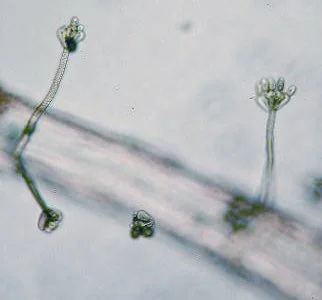Five Things to Know About Indoor Mold
1. What is mold and what are the health risks associated with it?
Microscopic view of Stachybotrys Chartarum, more commonly known as toxic black mold.
Mold is a type of fungi that can grow both indoors and outdoors. While some molds are harmless, others can release spores into the air that can cause respiratory problems, allergic reactions, and even infections.
There are three main types of these molds: allergenic, pathogenic, and toxigenic.
Allergenic molds are the most common type of mold, and they can cause allergic reactions in some people.
Pathogenic molds can cause infections, especially in people with weakened immune systems.
Toxigenic molds produce toxins that can be harmful to humans and should be treated by a certified professional.
Commonly referred to as black mold, Stachybotrys Chartarum, is a type of mold that produces toxins called mycotoxins. These toxins can cause a range of health problems, including respiratory problems, headaches, dizziness, fatigue, and skin rashes. In severe cases, exposure can lead to memory loss, joint pain, and liver damage.
2. The most common places to find mold in your home
Toxic mold discovered in between drywalls of a building. The space was likely compromised with moisture.
Mold typically grows in damp, dark, or humid environments. Some of the most common places to find indoor mold include:
Basements
Bathrooms
Crawl spaces
Kitchens
Laundry rooms and
In between walls that have been compromised with moisture
If you suspect that you have mold growing in your home or business, it's important to have it tested as soon as possible.
3. How to test for indoor mold
There are a variety of ways to test for mold. The most appropriate method will depend on the type of mold present and the extent of the contamination. While you can purchase a mold testing kit from your local hardware store, the majority of at home tests only test for surface mold and will not determine the amount of harmful airborne exposure. The most common method for mold inspection and testing that professionals use is through air sampling. This involves using a special device to take a sample of the air in a room or building and then sending it to a laboratory for analysis. The laboratory will identify any mold spores present in the sample and determine whether they are harmful. Once it is determined that dangerous mold is present, removal and growth prevention is vital to keep the area safe.
4. How to remove indoor mold



Once it’s been confirmed that you have toxic indoor mold, the next step is to remove it. Mold removal is the process of removing mold from an area through cleaning. However, simply removing the mold is often not enough, as the mold can return. Regrowth can occur when there is still moisture from water damage, water leaks, condensation, water infiltration, poor air circulation, or flooding damage. Mold remediation is the process of removing mold and repairing the damage it has caused, while also taking measures such as encapsulating the area to mitigate chances of it returning.
If you have mold in your home, it's important to take action as soon as possible. While removal is great first step, remediation and encapsulation can stop the spread of mold and help improve your indoor air quality and protect your health. Remediation should be done by a certified professional, to ensure that it is done safely and properly.
4. Prevention tips to keep indoor mold from growing
A worker sprays a paint like sealant to encapsulate a wall that has been treated for toxic mold. This will prevent further growth so that the mold will not return.
There are a few things you can do to prevent mold from growing in your home, such as:
Keep your home clean and free of clutter.
Fix any leaks or moisture problems immediately.
Use an air purifier with HEPA filter to remove mold spores from the air.
Make sure your home has adequate ventilation.
Mold can be a serious problem in your home, but by following these tips and knowing what to look for, you can help keep your indoor air quality high and protect your health.



